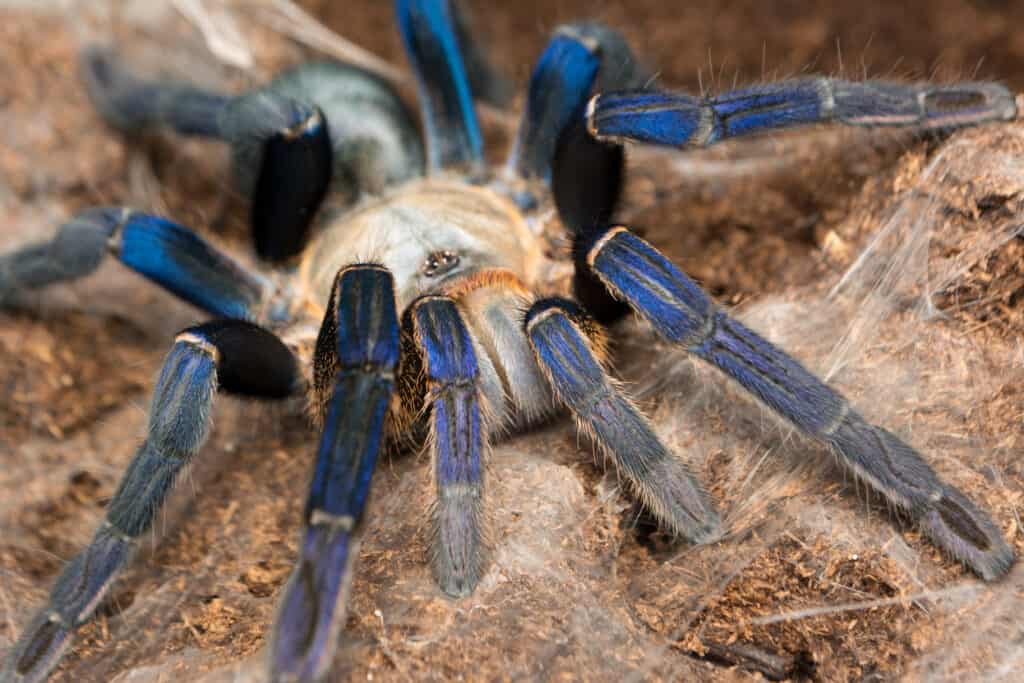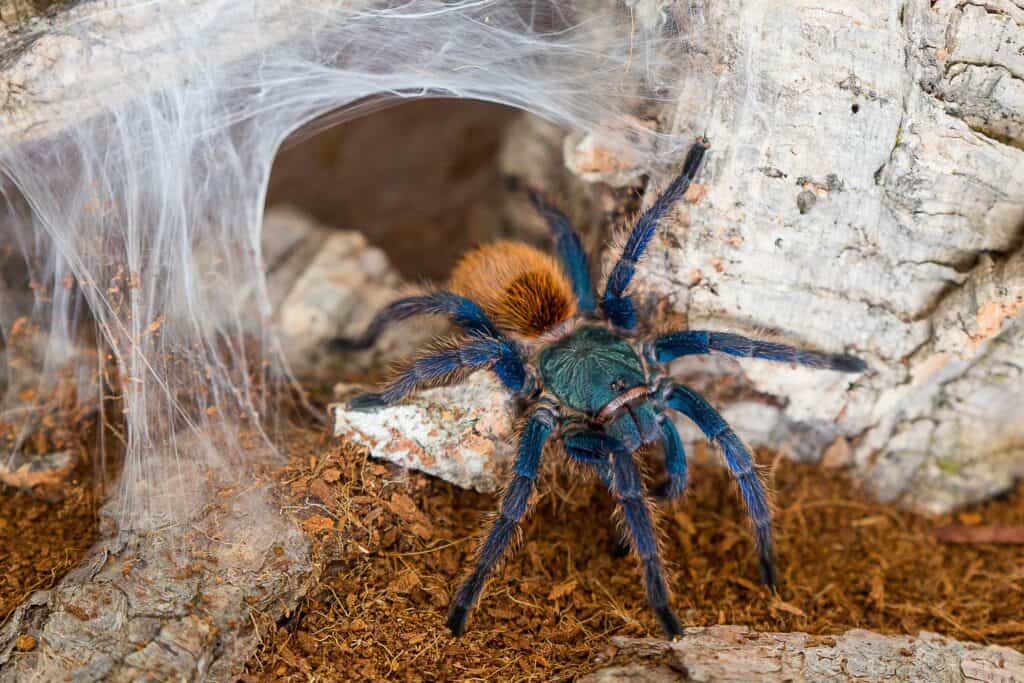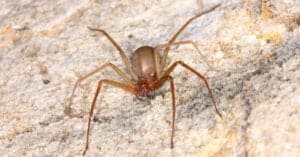Tarantulas are arguably the least cuddly pets in the world. You can’t handle your pet tarantula or play with it like you would a dog or a cat. However, they still make excellent pets for most people, mainly because they’re so easy to maintain. This elegant pet takes up very little space and has relatively few needs. This makes caring for a tarantula easy for most people. Of course, keeping a pet tarantula is still a serious responsibility.
If well cared for, your tarantula can live for several years. Despite their large size, they tend to be very delicate. They also prefer warm places, and their housing has to be secure. You don’t want your tarantula getting out of its enclosure as that would cause a major scare. These are just a few essential considerations if you intend to keep this spider in your home. Read on to discover some things about caring for a tarantula.
What Type of Tarantula Should You Keep?

Generally, ground-dwelling tarantulas are always the best for beginners.
©xtotha/Shutterstock.com
Tarantulas belong to the family Theraphosidae which contains about 1,000 species of arachnids. The species that are most commonly kept as a pet is Grammostola rosea (commonly known as the Chilean rose). This is a resilient spider that is native to Chile but is now found in various countries all over the world. The hardy nature of this spider makes it such an excellent pet to keep.
However, if you’re a beginner at keeping spiders, you should probably consider other species that are even easier to care for. Generally, ground-dwelling tarantulas are always the best for beginners. Tree dwellers are agile and quick, which makes them more challenging to handle.
Experts often recommend starting with an easy-to-handle species like the curly-hair tarantula (Tliltocatl albopilosus) or the Mexican red knee (Brachypelma smithi). However, if you prefer a tree-dwelling species, the pink-toe tarantula (Avicularia avicularia) would work. Other docile spider breeds that will be relatively easy to keep include Costa Rican zebras, pink zebra beauty, and pink toe.
Housing Considerations When Caring for Tarantula
Tarantulas are solitary animals which means they are best housed alone in a cage. If you’re keeping one as a pet, you must pay special attention to its housing needs. Generally, housing for a tarantula should be as close to its natural habitat as possible. The enclosure also needs to be secure if you don’t want your tarantula to get out of its cage. However, it should still get enough ventilation.
You don’t need a large cage to keep a tarantula. In fact, a big enclosure is not recommended as it makes it difficult for them to find prey. Tarantulas have an average leg span of 5-8 inches. The length of the spider enclosure should be at least three times this leg span, while the width should be about two times the leg span. If you’re keeping a ground-dwelling species, you don’t have to worry about the height-—just make it as high as the spider’s leg span. Tree-dwelling spiders need a taller enclosure (about a foot) with branches on which they can climb. The enclosure should also have a possible hiding spot, such as a half-hollow log or a cork bark.
One of the best things about keeping pet tarantulas is that they don’t have unique temperature requirements. Most species do great at room temperature. To make the enclosure look as natural as possible, you can line the bottom with a substrate such as vermiculite or a mix of peat and vermiculite. The base substrate should be thick enough for them to burrow into.
Housing requirements may also vary from one species to the other. For instance, some species of tarantulas thrive better in high humidity. If you’re keeping a spider like this, you must mist its enclosure at least once daily to keep the humidity up.
Cleaning Tarantula Housing
Cleaning tarantula housing is one of the most challenging aspects of keeping one. Since they cannot be handled directly, you must figure out a way to safely get the spider out of the cage. In most cases, the trick is to get the spider into a small container which you can use to transport it instead of handling it with your hands.
Generally, you should spot-clean your spider’s enclosure as needed, removing unwanted materials, including uneaten food, every 24 hours. Deep cleaning can be done less regularly (every 4–6 months).
Grooming
Tarantulas don’t have any special grooming needs. The spider molts regularly, and that’s how they groom themselves. As long as the enclosure is at the proper humidity for the species you’re keeping, it should molt on its own without assistance. Avoid feeding your tarantulas live prey when they’re molting.
Feeding Your Tarantula

Young spiders feed more often (daily or on a two-day routine), while adults can be fed less often.
©tempisch/Shutterstock.com
Tarantulas prefer live prey, and crickets are their favorite. Other insects, such as roaches, mealworms, and superworms, may also work as food. For larger tarantulas, you’ll need bigger prey, like small lizards or pinkie mice. Since spiders are more active at night, you should drop prey in the enclosure in the evenings.
You can feed the insect some nutritious foods before feeding it to your spider. Some people also dust the prey with vitamin powder to provide additional nutrients. The size of prey and frequency of feeding often depends on the age and size of your spider. As a general rule, the size of prey you’re feeding to your tarantula should be smaller than the spider. Young spiders feed more often (daily or on a two-day routine), while adults can be fed less often. Specific feeding requirements may apply depending on your spider’s species, age, or size.
Tarantulas take water, and a dish of fresh water should always be available in your spider’s enclosure. Keep the container shallow to keep your spider from drowning in it. Alternatively, you can place a small rock in the dish, which the spider can climb on.
How Much Does Caring for a Tarantula Cost?
Tarantulas are relatively cheap pets to keep. The main upkeep cost is the spider’s food. The monthly cost can range from $5 to $10. You may even spend less than this if you opt to raise crickets yourself instead of buying them. Other likely costs you may incur include periodic substrate changes (between $10 and $20) and veterinary checkups as necessary.
Caring for Tarantula—Special Consideration
Tarantulas aren’t the most pleasant pets in the world. While many pet breeds are docile, they still have a toxic venom that can cause a local reaction. The side effect of a tarantula bite is similar to a bee sting for most people. However, for people who are allergic to the venom, a bite can cause severe reactions.
Tarantulas are the gentle giants of the spider world. Some people even allow their spiders to walk on their bodies. However, if the spider feels threatened, it will deliver a venomous bite. Even if it doesn’t bite, handling a tarantula is still not recommended. They have barbed hairs on their abdomen, which can cause itching and irritation if it gets on the skin. The hair can also cause inflammation if it gets into your eyes. Only handle as necessary, and wash your hands right away. You should also keep pets and children away from your tarantula and secure it, so it doesn’t get out.
Up Next
The photo featured at the top of this post is © KobchaiMa/Shutterstock.com
Sources
- Tarantulas and other Arachnids / Accessed October 12, 2022
- The Spruce Pets / Accessed October 12, 2022
- The Spruce Pets / Accessed October 12, 2022
- Tom's Big Spiders / Accessed October 12, 2022
Thank you for reading! Have some feedback for us? Contact the AZ Animals editorial team.







